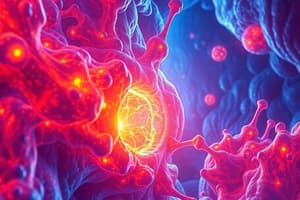Podcast
Questions and Answers
Which process describes the replacement of damaged tissues by healthy new tissue?
Which process describes the replacement of damaged tissues by healthy new tissue?
- Dysplasia
- Repair (correct)
- Metaplasia
- Hyperplasia
What type of tissue repair involves the replacement of damaged cells with granulation tissue that matures into fibrous tissue?
What type of tissue repair involves the replacement of damaged cells with granulation tissue that matures into fibrous tissue?
- Hypertrophy
- Regeneration
- Fibrosis (correct)
- Atrophy
Which of the following is NOT a factor that determines the type of repair?
Which of the following is NOT a factor that determines the type of repair?
- Blood supply
- Ability of tissue to proliferate
- Severity of damage
- Tissue irradiance (correct)
Which type of cells can proliferate continuously throughout life?
Which type of cells can proliferate continuously throughout life?
Which of the following is an example of a labile cell?
Which of the following is an example of a labile cell?
Which of these cells has a limited capacity to proliferate, doing so only when needed?
Which of these cells has a limited capacity to proliferate, doing so only when needed?
Which cells cannot proliferate at all?
Which cells cannot proliferate at all?
Which of the following factors does NOT directly affect the mechanism of tissue repair?
Which of the following factors does NOT directly affect the mechanism of tissue repair?
What is the primary role of growth factors in tissue repair?
What is the primary role of growth factors in tissue repair?
Regeneration of skin refers to healing by labile cells whereas fibrosis refers to healing by?
Regeneration of skin refers to healing by labile cells whereas fibrosis refers to healing by?
What is the outcome of severe cell injury with a destroyed fibrous framework in the liver?
What is the outcome of severe cell injury with a destroyed fibrous framework in the liver?
What is the term for the process of healing in the central nervous system (CNS) where necrotic cells are replaced by proliferating neuroglia cells?
What is the term for the process of healing in the central nervous system (CNS) where necrotic cells are replaced by proliferating neuroglia cells?
What is a traumatic neuroma, which can occur during peripheral nerve repair?
What is a traumatic neuroma, which can occur during peripheral nerve repair?
What type of callus is formed first during the healing of a bone fracture?
What type of callus is formed first during the healing of a bone fracture?
Which cells are responsible for removing the un-needed callus during bone remodeling?
Which cells are responsible for removing the un-needed callus during bone remodeling?
Which of the following can interfere with bone union?
Which of the following can interfere with bone union?
What is the main component of granulation tissue during healing by fibrosis?
What is the main component of granulation tissue during healing by fibrosis?
What is fibrogenesis?
What is fibrogenesis?
During primary union of wounds, how do basal cells contribute to epidermal regeneration?
During primary union of wounds, how do basal cells contribute to epidermal regeneration?
A patient presents with a persistent loss of continuity of the skin on their lower leg. Upon examination, the area is not healing and remains an open sore. Which complication of wound healing is most likely?
A patient presents with a persistent loss of continuity of the skin on their lower leg. Upon examination, the area is not healing and remains an open sore. Which complication of wound healing is most likely?
Flashcards
What is tissue repair/healing?
What is tissue repair/healing?
Replacement of damaged tissues with healthy new ones.
What is repair by regeneration?
What is repair by regeneration?
Replacement of damaged cells with new, healthy cells of the same type.
What is repair by fibrosis?
What is repair by fibrosis?
Replacement of damaged cells with granulation tissue maturing into fibrous tissue.
What factors determine repair type?
What factors determine repair type?
Signup and view all the flashcards
What are labile cells?
What are labile cells?
Signup and view all the flashcards
What are stable cells?
What are stable cells?
Signup and view all the flashcards
What are permanent cells?
What are permanent cells?
Signup and view all the flashcards
What is the role of growth factors?
What is the role of growth factors?
Signup and view all the flashcards
What regenerates easily in skin?
What regenerates easily in skin?
Signup and view all the flashcards
When does perfect liver regeneration occur?
When does perfect liver regeneration occur?
Signup and view all the flashcards
What is gliosis in the CNS?
What is gliosis in the CNS?
Signup and view all the flashcards
What happens after a peripheral nerve injury?
What happens after a peripheral nerve injury?
Signup and view all the flashcards
What are the stages of bone healing?
What are the stages of bone healing?
Signup and view all the flashcards
What causes bone union failure?
What causes bone union failure?
Signup and view all the flashcards
How does fibrosis occur?
How does fibrosis occur?
Signup and view all the flashcards
What is Fibrogenesis?
What is Fibrogenesis?
Signup and view all the flashcards
What is a chronic ulcer?
What is a chronic ulcer?
Signup and view all the flashcards
What is a chronic sinus?
What is a chronic sinus?
Signup and view all the flashcards
What is a keloid?
What is a keloid?
Signup and view all the flashcards
What is an implantation epidermoid cyst?
What is an implantation epidermoid cyst?
Signup and view all the flashcards
Study Notes
- Repair, also known as healing, is the replacement of damaged tissues with healthy, new tissue.
- The type of repair depends on the type of cells and their ability to divide and proliferate
Types of Repair
- Repair by regeneration refers to the replacement of damaged cells with new healthy cells of the same type.
- Repair by fibrosis is the replacement of damaged cells by granulation tissue, which matures into fibrous tissue
Factors Determining the Type of Repair
- Severity of damage (stroma)
- Blood supply
- Persistent infection or presence of a foreign body
- Ability of tissue to proliferate
Types of Cells
- Labile cells can proliferate continuously and have good power of division.
- Labile cells include stratified squamous epithelium of skin/mucous membranes, transitional epithelium of the urinary tract, columnar epithelium, and hemopoietic/lymphoid cells.
- Stable cells can proliferate when needed, have limited power of division, and undergo regeneration after minor injury but fibrosis after major injury.
- Stable cells include parenchymatous cells of the liver, pancreas, glands, and renal tubules, as well as mesenchymal cells like osteoblasts, chondroblasts, and fibroblasts.
- Permanent cells cannot proliferate and include muscle cells (cardiac and skeletal) and nerve cells (brain/spinal cord).
General Factors Affecting Repair
- Age
- Nutritional deficiency
- Drugs
- Endocrine diseases
Mechanisms of Repair
- Growth factors help cell division, migration, proliferation, and DNA synthesis, are released from damaged cells, platelets, macrophages and lymphocytes, and include epidermal growth factor (EGF) and platelet-derived growth factor (PDGF).
- Cell-to-cell interactions
- Cell-to-matrix interactions
Repair by Regeneration Examples
- Skin Regeneration
- Epidermis alone regenerates easily
- Dermis heals by granulation tissue (fibrosis)
- Liver cells (stable cells)
- Mild cell injury with intact fibrous framework allows perfect regeneration.
- Severe cell injury with destroyed fibrous framework leads to irregular fibrosis and liver cirrhosis.
Repair in the Nervous System
- Central Nervous System (permanent cells)
- No regeneration occurs; necrotic cells are removed by microglia and replaced by proliferating neuroglia cells, which is called gliosis.
- Peripheral Nerves: Regeneration can occur
- Nerve cells swell, Nissl granules disappear, nuclei become eccentric, and myelin sheath/axis cylinder disintegrate after nerve injury.
- Schwann cells proliferate and form continuous neurilemmal tubes.
- New axons grow from the proximal end and reformation of the myelin sheath occurs.
- If cut nerve ends are not in direct opposition, Schwann cells and growing axons mix, forming a painful mass called traumatic (stump or amputation) neuroma.
Healing of Bone Fracture
- A hematoma forms at the fracture site with acute inflammation, and growth factors are released.
- The hematoma is invaded by fibroblasts, osteoblasts, and new capillaries to form a soft callus or procallus.
- The procallus converts to fibro-cartilaginous callus, then osteoid callus, and finally hard bony callus by progressive endochondral ossification.
- Unneeded callus is removed by osteoclasts, followed by remodeling of the intermediate callus with deposition of calcium phosphate and carbonate.
- Bone marrow regenerates later.
Bone Union Failure Causes
- Faulty immobilization leading to fibrous union
- Infection
- Impaired blood supply
- Interposition of soft tissue
- Nutritional disturbance
Examples of Repair by Granulation (Healing by Fibrosis)
- Granulation tissue, consisting of proliferating fibroblasts and anastomosing capillaries, matures into fibrous tissue through:
- Fibrogenesis: migration and proliferation of fibroblasts at the injury site.
- Angiogenesis (Neovascularization): migration and proliferation of endothelial cells leading to anastomosing capillary loops.
- Fibroblasts secrete extracellular matrix proteins and collagen types I and III.
- Remodeling and maturation of granulation tissue by progressive collagen synthesis, resorption of capillaries, and myofibroblast contraction, leading to mature scar formation.
Healing of Wounds
- Primary union of wounds (Healing by first intention) occurs in non-infected incised wounds with minimal tissue destruction and approximated edges via surgery.
- Basal cells proliferate, crossing the gap to form the whole epidermis.
- Macrophages start phagocytosis on day 3.
- The gap fills with granulation tissue on days 4-5 without skin adnexa.
- Secondary union of wounds occurs in infected wounds with excess tissue destruction and gaping edges typically due to an accident.
- Basal cells proliferate but cannot cross the gap until it is filled by granulation tissue infiltrated by polymorphs and macrophages.
- Phagocytosis takes a long time.
- The basal layer covers the thick granulation tissue forming the whole epidermis without skin adnexa.
Possible Wound Healing Complications
- Chronic ulcer: Persistent loss of continuity of the covering that may affect skin or mucous membrane.
- Chronic sinus:A blind-ended tract between a deep wound (or abscess) and the skin, lined by infected granulation tissue due to the presence of a foreign body or infection.
- Chronic fistula involves a tract between two surface epithelia or hollow organs like the esophagus and trachea.
- Keloid is a large projecting scar covered by thin, stretched skin, caused by excessive repair and foreign body reactions to hairs, keratin, cotton, or fibers with unknown etiology.
- Interference with movements occurs due to scar contraction at joints.
- Implantation epidermoid cycts occur when epithelial cells get trapped in the dermis and proliferate, forming a cyst linked by stratified squamous epithelium filled with keratin.
- Malignant transformation may rarely develop in old scars, especially burns.
Studying That Suits You
Use AI to generate personalized quizzes and flashcards to suit your learning preferences.


